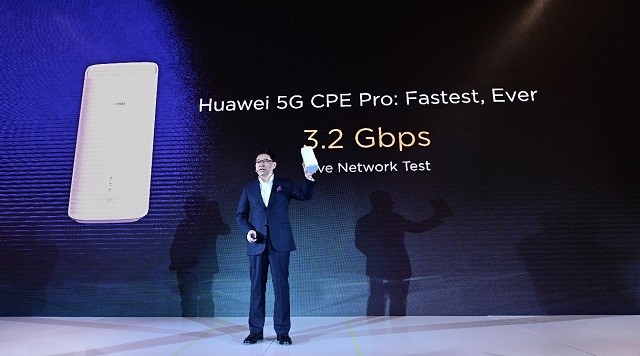By Alex Pluemer, contributing writer
Huawei recently launched several new products designed to provide end-to-end 5G capabilities to the next generation of connected and mobile devices and to support large-scale 5G network development worldwide.
The Balong 5000, a 5G multi-mode chipset, and the first commercial device powered by it, the Huawei 5G CPE Pro, are touted by the company as providing the world’s fastest wireless connections for smartphones, home broadband devices, vehicle-mounted devices, and 5G modules.
Boasting a small form factor and a high degree of integration, the Balong 5000 is the first chipset to perform to industry benchmarks for peak 5G download speeds, according to Huawei. It can achieve download speeds of up to 4.6 Gbits/s at sub-6-GHz frequency bands (low-frequency bands used as the main spectrum for 5G) and download speeds of up to 6.5 Gbits/s on the mmWave spectrum (high-frequency bands used as an extended spectrum for 5G). Those speeds are 10 times faster than the top 4G LTE speeds currently on the market.
The Balong 5000 supports 2G, 3G, 4G, and 5G networks on a single chip and reduces latency and power consumption when exchanging data between different modes. It’s also the first multi-mode chipset that supports vehicle-to-everything (V2X) communications, offering low latency and reliable solutions for vehicles featuring on-board connectivity.
The Balong 5000 also supports both standalone (SA) and non-standalone (NSA) network architectures, meaning that it can support different user and carrier requirements for connectivity during various stages of 5G development. Non-standalone 5G architectures are built on top of existing 4G LTE networks, while standalone 5G architectures are created independently of existing networks.

The Huawei 5G CPE Pro supports both 4G and 5G wireless communication. A 1-GB HD video clip can be downloaded within three seconds on a 5G network, and 8K video can be streamed smoothly without lag time, setting a new benchmark for home CPEs. The device can be implemented in homes and in small- to medium-sized business environments to provide high-speed broadband access. By adopting new Wi-Fi 6 technology, the Huawei 5G CPE Pro can deliver speeds of up to 4.8 Gbits/s and is the first 5G CPE to support HUAWEI HiLink protocols for bringing smart homes into the 5G era.
The company also launched the Huawei TIANGANG, the industry’s first 5G core chip designed specifically for 5G base stations. Highly integrated, the chip can support large-scale integration of active power amplifiers (PAs) and passive antenna arrays into very small antennas. The chip also provides high computing capacity, boasting a 2.5-fold increase over its predecessors. A single chip can control up to 64 channels, the industry’s highest standard, by implementing the latest algorithms and beamforming technology. The Huawei TIANGANG also supports the 200-MHz high spectral bandwidth, making it ready for the deployment of future networks.
To help address issues like site acquisition and network deployment costs, the chip also features 50% smaller and 23% lighter active antenna units (AAUs). 5G base stations can be deployed in approximately half the time that it took to install their 4G counterparts.
Huawei also touts the first data center switch with an AI brain. Enabling zero Ethernet packet loss and end-to-end latency of less than 10 milliseconds, the switch also offers more computing capacity than 25 mainstream two-way CPU servers combined while consuming less than 8 W of power, according to Huawei.
Advertisement
Learn more about Electronic Products Magazine





